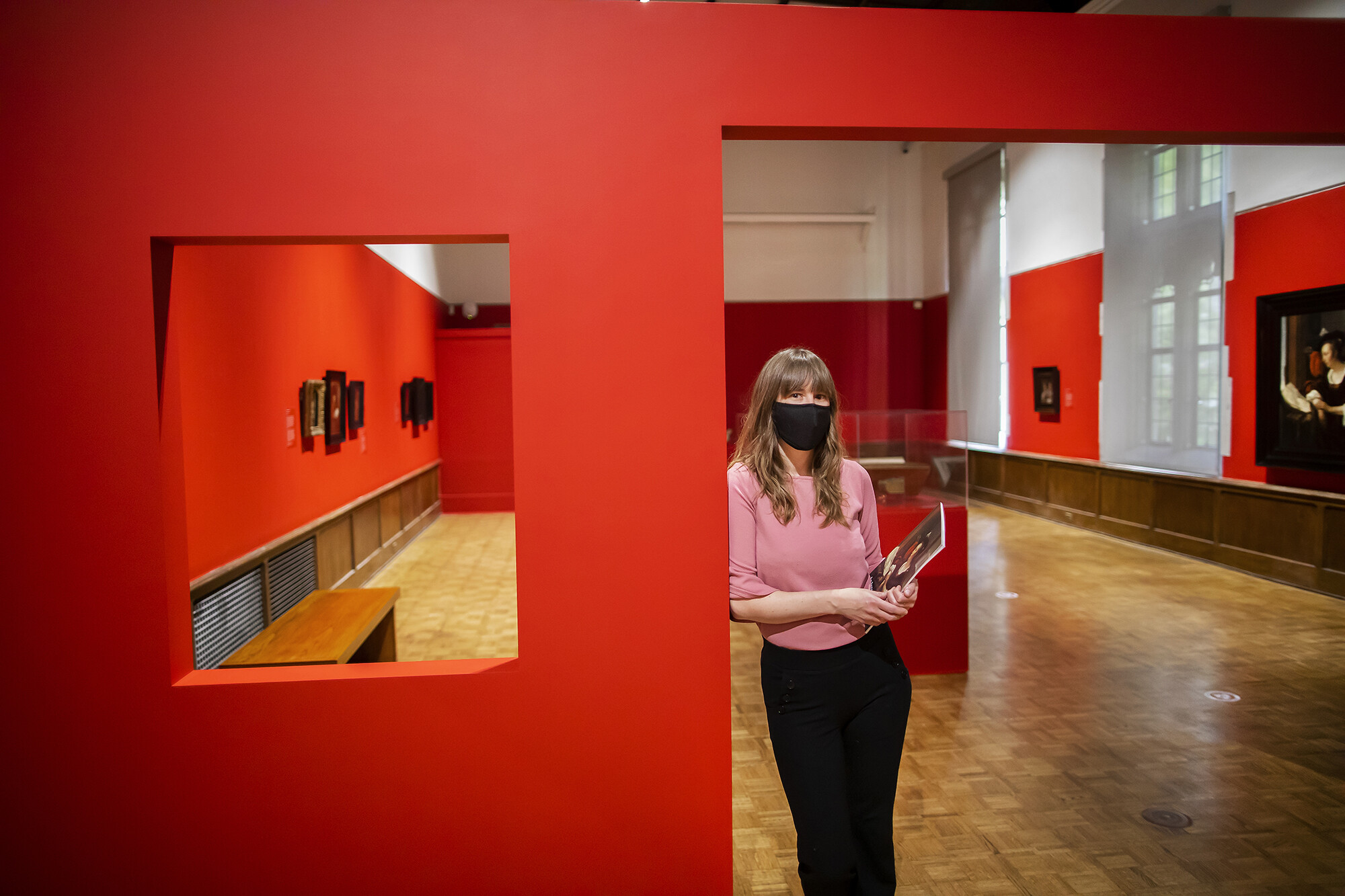
(From left) Doctoral student Hannah Yamagata, research assistant professor Kushol Gupta, and postdoctoral fellow Marshall Padilla holding 3D-printed models of nanoparticles.
(Image: Bella Ciervo)

The window in a new wall constructed in the Arthur Ross Gallery provides a unique peek into the room-within-a-room created for a new exhibition, “An Inner World: Seventeenth-Century Dutch Genre Painting,” on view through July 25.
The gallery’s transformation reflects the curatorial intent of “An Inner World,” a character of intimacy, contemplation, and inner reflection. The window echoes windows featured in many of the works, while the deep red on the walls picks up on the crimson drawn from paintings from the period.
The exhibition was co-curated by Heather Gibson Moqtaderi, assistant director and curator of the Gallery, and Lara Yeager-Crasselt, curator of The Leiden Collection in New York City. The Gallery also offers a 30-minute virtual tour.
“‘An Inner World’ offers a window into the intellectual and domestic lives of men and women in the Dutch Republic in the 1600s,” Moqtaderi says.
“The paintings on view are meaningful today because they invite contemplation and close observation,” she says. “These thoughtful—and often finely detailed—paintings reflect a period during which scientific inquiry, philosophy, and religious scholarship flourished in the northern Netherlands. We developed this exhibition to reflect this atmosphere of quiet contemplation for today’s visitors.”
These rare, early paintings are on loan from and the Sterling and Francine Clark Art Institute in Williamstown, Massachusetts, where the exhibition was originally installed in 2017. The Arthur Ross exhibition is expanded with three additional paintings and enhanced by selected rare books from the Penn Libraries Kislak Center for Special Collections, Rare Books, and Manuscripts.
“An Inner World” was originally curated by Yeager-Crasselt, who was interim curator of painting and sculptures for the Clark at the time. Moqtaderi reached out to Yeager-Crasselt on behalf of the Arthur Ross Gallery three years ago to request that the exhibition travel to Penn. “I gravitated toward the conceptual framework around the inner world of the mind and interior spaces of the 17th century,” Moqtaderi says.

The exhibition centers around the 1653-54 painting “Woman Reading a Book by a Window” by Gabriel Metsu, which at 41-by-35 inches also happens to be the largest of the exhibition’s 10 paintings. The oil depicts a woman scholar, dressed in a costume that would have been antique for her time, lifting her eyes from her book to gaze outside through a window, Moqtaderi says.
“Metsu’s painting goes beyond depicting a moment in 17th-century life, as it also serves as an allegory for knowledge,” she says. The context of the exhibition is the northern Netherlands, specifically the city of Leiden, about 30 miles southwest of Amsterdam, where the first university in the country was established, in 1574.
The books displayed in the gallery’s glass cases were chosen in consultation with Shira Brisman, assistant professor of early modern art in Penn’s History of Art Department, and the Penn Libraries’ Nicholas Herman, curator at the Schoenberg Institute for Manuscript Studies, and John Pollack, Kislak Center research services curator.
The texts on display echo themes depicted in the paintings. For example, the “Iconologia for Moral Emblems” by Cesare Ripa from 1764-67, on view near Metsu’s “Woman Reading,” is open to an allegorical illustration of a woman seated, holding a torch representing illumination and knowledge. Other early books on view represent moral emblems, women’s education, alchemy, and religious devotion. Its original embroidered cover intact, is a Dutch translation of the Bible from the 17th century.
Most of the paintings are small in scale, intended to be viewed up close in intentionally intimate spaces, such as a collector’s cabinet, Moqtaderi says, which is what inspired the Gallery’s new interior wall, painted red, with a window and a doorway.
“Many of these paintings depict individuals at windows that serve as thresholds between the inner and outer world,” she says. “The window is both a physical and conceptual threshold between public and private life, allowing us to catch a glimpse of the inner world from the outside.”
Upcoming virtual events related to the exhibition include a performance by Filament Baroque Ensemble at 6 p.m. on June 17 and a 12@12 gallery talk by Lara Yeager-Crasselt at noon on July 7.
Louisa Shepard

(From left) Doctoral student Hannah Yamagata, research assistant professor Kushol Gupta, and postdoctoral fellow Marshall Padilla holding 3D-printed models of nanoparticles.
(Image: Bella Ciervo)

Jin Liu, Penn’s newest economics faculty member, specializes in international trade.
nocred

nocred

nocred